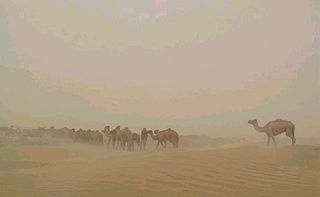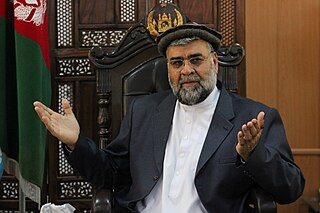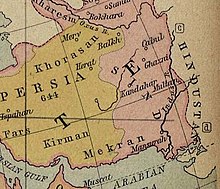
Dari, also known as Dari Persian, is the variety of the Persian language spoken in Afghanistan. Dari is the term officially recognised and promoted since 1964 by the Afghan government for the Persian language; it is known as Afghan Persian or Eastern Persian in many Western sources. The decision behind renaming the local variety of Persian was more political than linguistic to support an Afghan state narrative. Apart from a few basics of vocabulary, there is little difference between formal written Persian of Afghanistan and Iran; the languages are mutually intelligible. The term "Dari" is officially used for the characteristic spoken Persian of Afghanistan, but is best restricted to formal spoken registers. Afghanistan's Persian-speaking population still prefer to call their language "Farsi", asserting that the term "Dari" has been imposed upon them by the dominant Pashtun ethnic group as an effort to detach Afghanistan from its deep-rooted cultural, linguistic, and historical connections with the wider Persian-speaking world, encompassing Iran, Tajikistan, and parts of Uzbekistan. Dari is the official language for 35 million Afghans in Afghanistan and it serves as the lingua franca for interethnic communications in Afghanistan.

The population of Afghanistan is around 41 million as of 2023. The nation is composed of a multi-ethnic and multilingual society, reflecting its location astride historic trade and invasion routes between Central Asia, South Asia, and Western Asia. Ethnic groups in the country include Pashtun, Tajik, Hazara, Uzbek, as well as smaller groups such as Nuristani, Aimaq, Turkmen, Baloch, and some others which are less known. Together they make up the contemporary Afghan people.

The music of Afghanistan comprises many varieties of classical music, folk music, and modern popular music. Afghanistan has a rich musical heritage and features a mix of Persian melodies, Indian compositional principles, and sounds from ethnic groups such as the Pashtuns, Tajiks and Hazaras. Instruments used range from Indian tablas to long-necked lutes. Afghanistan's classical music is closely related to Hindustani classical music while sourcing much of its lyrics directly from classical Persian poetry such as Mawlana Balkhi (Rumi) and the Iranian tradition indigenous to central Asia. Lyrics throughout most of Afghanistan are typically in Dari (Persian) and Pashto. The multi-ethnic city of Kabul has long been the regional cultural capital, but outsiders have tended to focus on the city of Herat, which is home to traditions more closely related to Iranian music than in the rest of the country.

Balkh is a town in the Balkh Province of Afghanistan, about 20 km (12 mi) northwest of the provincial capital, Mazar-e Sharif, and some 74 km (46 mi) south of the Amu Darya river and the Uzbekistan border. Its population was estimated to be 138,594 in 2021-22 by the Afghan National Statistic and Information Authority. Listed as the current 8th most populous city in the country, 2024 estimates set the population of Balkh at 114,883.

Balkh is one of the 34 provinces of Afghanistan, located in the north of the country. It is divided into 15 districts and has a population of about 1,509,183, which is multi-ethnic and mostly a Persian-speaking society. The city of Mazar-i-Sharif serves as the capital of the province. The Mazar-i-Sharif International Airport and Camp Marmal sit on the eastern edge of Mazar-i-Sharif.

Jowzjan, sometimes spelled Jawzjan or Jozjan, is one of the thirty-four provinces of Afghanistan, located in the north of the country bordering neighboring Turkmenistan. The province is divided into 11 districts and contains hundreds of villages. It has a population of about 613,481, which is multi-ethnic and mostly agriculturalists. Sheberghan is the capital of Jozjan province.

Kandahār is one of the thirty-four provinces of Afghanistan, located in the southern part of the country, sharing a border with Pakistan, to the south. It is surrounded by Helmand in the west, Uruzgan in the north and Zabul Province in the east. Its capital is the city of Kandahar, Afghanistan's second largest city, which is located on the Arghandab River. The greater region surrounding the province is called Loy Kandahar. The Emir of Afghanistan sends orders to Kabul from Kandahar making it the de facto capital of Afghanistan, although the main government body operates in Kabul. All meetings with the Emir take place in Kandahar, meetings excluding the Emir are in Kabul.

Nimruz or Nimroz is one of the 34 provinces of Afghanistan, located in the southwestern part of the country. It lies to the east of the Sistan and Baluchestan Province of Iran and north of Balochistan, Pakistan, also bordering the Afghan provinces of Farah and Helmand. It has a population of about 186,963 people. The province is divided into five districts, encompassing about 649 villages.

The culture of Afghanistan has persisted for over three millennia, tracing record to at least the time of the Achaemenid Empire in 500 BCE, and encompasses the cultural diversity of the nation. Afghanistan's culture is historically strongly connected to nearby Persia, including the same religion, as the people of both countries have lived together for thousands of years. Its location at the crossroads of Central, South and Western Asia historically made it a hub of diversity, dubbed by one historian as the "roundabout of the ancient world".

Fārsīwān is a contemporary designation for Persian speakers in Afghanistan and its diaspora elsewhere. More specifically, it was originally used to refer to a distinct group of farmers in Afghanistan and urban dwellers. In Afghanistan, original Farsiwans are found predominantly in Herat and Farah provinces. They are roughly the same as the Persians of eastern Iran. The term excludes the Hazāra and Aymāq tribes, who also speak dialects of Persian.

New Persian, also known as Modern Persian is the current stage of the Persian language spoken since the 8th to 9th centuries until now in Greater Iran and surroundings. It is conventionally divided into three stages: Early New Persian, Classical Persian, and Contemporary Persian.

Fazlullah Mujadedi also known as Abdul Hameed Mujadedi or Abdul Hameed Fazlullah Mujadedi was an Afghan politician in Afghanistan, previously serving as Governor of Logar, Laghman and Takhar provinces. He was one of the prominent commanders of Jamiat-e Islami during the 1980s Soviet–Afghan War. He was amongst the earliest generation of anti-Soviet fighters from Kabul University, which included Amin Wardak, Zabihullah of Marmul in Balkh and Ahmad Shah Massoud.

Afghanistan is a linguistically diverse nation, with upwards of 40 distinct languages. However, Dari and Pashto are two of the most prominent languages in the country, and have shared official status under various governments of Afghanistan. Dari, as a shared language between multiple ethnic groups in the country, has served as a historical lingua franca between different linguistic groups in the region and is the most widely understood language in the country. Pashto is also widely spoken in the region; but the language does not have a diverse multi-ethnic population like Dari, and the language is not as commonly spoken by non-Pashtuns. Dari and Pashto are also "relatives", as both are Iranian languages.
Persianization or Persification, is a sociological process of cultural change in which a non-Persian society becomes "Persianate", meaning it either directly adopts or becomes strongly influenced by the Persian language, culture, literature, art, music, and identity as well as other socio-cultural factors. It is a specific form of cultural assimilation that often includes a language shift. The term applies not only to cultures, but also to individuals, as they acclimate to Persian culture and become "Persianized" or "Persified".

Central Asian Arabic or Jugari Arabic is a variety of Arabic currently facing extinction and spoken predominantly by Arab communities living in portions of Central Asia.
Mohammad Gul Khan Momand, was both a literary figure and a politician in Afghanistan. He also served as an Army Officer during Afghanistan's Independence war in 1919. He served numerous Government and Leadership positions including Home Minister of Afghanistan.

Kholm or Khulm, formerly known as Tashqurghan, is a town in Samangan Province of northern Afghanistan, 60 km east of Mazar-i-Sharif one-third of the way to Kunduz. Kholm is an ancient town located on the fertile, inland delta fan of the Khulm River. As such, it is an agriculturally rich locale and densely populated. It is famous for its covered market, and is a centre for trading in sheep and wood.

Afghan literature or literature of Afghanistan refers to the literature produced in the Islamic Emirate of Afghanistan. Influenced by Central and South Asian literature, it is predominantly written in two native and official languages of Afghanistan, Dari and Pashto. Some regional languages such as Uzbek, Turkmen, Balochi, and Pashayi also appears in Afghan literature. While Afghanistan is a multilingual country, these languages are generally used as oral compositions and written texts by the Afghan writers and in Afghan curriculum. Its literature is highly influenced by Persian and Arabic literature in addition to Central and South Asia.
An Afghan personal name consists of a given name and sometimes a surname at the end. Personal names are generally not divided into first and family names; a single name is recognized as a full personal name, and the addition of further components – such as additional given names, regional, or ethnic family/clan names or patronymics – is often a matter of parents' choice. This structure is shared amongst the different ethnicities of Afghanistan and people of Khyber Pakhtunkhwa.



















